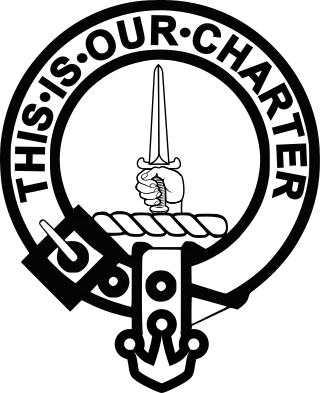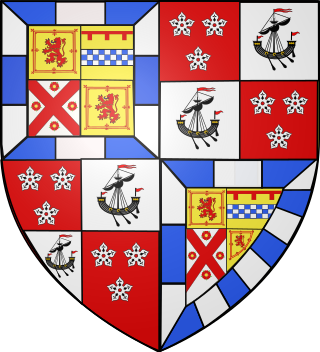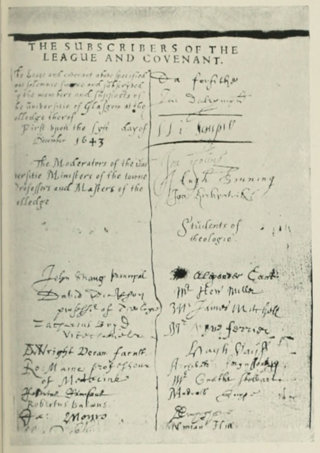| |||||
| Centuries: | |||||
|---|---|---|---|---|---|
| Decades: | |||||
| See also: | List of years in Scotland Timeline of Scottish history 1584 in: England • Elsewhere | ||||
Events from the year 1584 in the Kingdom of Scotland .
| |||||
| Centuries: | |||||
|---|---|---|---|---|---|
| Decades: | |||||
| See also: | List of years in Scotland Timeline of Scottish history 1584 in: England • Elsewhere | ||||
Events from the year 1584 in the Kingdom of Scotland .

The Lord President of the Court of Session and Lord Justice General is the most senior judge in Scotland, the head of the judiciary, and the presiding judge of the College of Justice, the Court of Session, and the High Court of Justiciary. The Lord President holds the title of Lord Justice General of Scotland and the head of the High Court of Justiciary ex officio, as the two offices were combined in 1836. The Lord President has authority over any court established under Scots law, except for the Supreme Court of the United Kingdom and the Court of the Lord Lyon.

Irvine is a town and former royal burgh on the coast of the Firth of Clyde in North Ayrshire, Scotland. The 2011 Census recorded the town's population at 33,698 inhabitants, making it the largest settlement in North Ayrshire, and 22nd largest settlement in Scotland. Irvine was designated at the fifth and final Scottish new town in November 1966. Irvine is the administrative centre and the seat of the North Ayrshire Council administration which has its headquarters based at Cunninghame House. Irvine was the site of Scotland's 12th century military capital and former headquarters of the Lord High Constable of Scotland, Hugh de Morville. It also served as the capital of Cunninghame and was, at the time of David I, Robert II and Robert III, one of the earliest capitals of Scotland.

Lord Gray is a title in the Peerage of Scotland. The Barony of Gray was created circa July 1445 for the Scottish diplomat and politician Sir Andrew Gray. The first Lord Gray was a hostage in England for the good conduct of James I of Scotland from 1424 to 1427, and was one of the knights who accompanied Lady Margaret Stewart to France for her marriage to Louis XI of France in 1436.

The office of Lord Clerk Register is the oldest remaining Great Officer of State in Scotland, with origins in the 13th century. It historically had important functions in relation to the maintenance and care of the public records of Scotland. Today these duties are administered by the Keeper of the National Records of Scotland and the Keeper of the Registers of Scotland.
The Lord Chancellor of Scotland, formally the Lord High Chancellor, was a Great Officer of State in the Kingdom of Scotland.
The Treasurer-depute was a senior post in the pre-Union government of Scotland. It was the equivalent of the English post of Chancellor of the Exchequer.

Poor Things: Episodes from the Early Life of Archibald McCandless M.D., Scottish Public Health Officer is an epistolary novel by Scottish writer Alasdair Gray, published in 1992. It won the Whitbread Award and the Guardian Fiction Prize the same year.

Clan Carnegie is a Lowland Scottish clan.

Clan Charteris is a Scottish clan of the Scottish Lowlands.

The Prior, then Abbot and then Commendator of Dunfermline was the head of the Benedictine monastic community of Dunfermline Abbey, Fife, Scotland. The abbey itself was founded in 1128 by King David I of Scotland, but was of earlier origin. King Máel Coluim mac Donnchada had founded a church there with the help of Benedictines from Canterbury. Monks had been sent there in the reign of Étgar mac Maíl Choluim and Anselm had sent a letter requesting that Étgar's brother and successor King Alaxandair mac Maíl Coluim protect these monks. By 1120, when Alaxandair sent a delegation to Canterbury to secure Eadmer for the bishopric of St Andrews, there is a Prior of the Dunfermline monks by the name of Peter leading the delegation. Control of the abbey was secularized in the 16th century and after the accession of James Stewart in 1500, the abbey was held by commendators. In the second half of the 16th century, the abbey's lands were being carved up into lordships and it was finally annexed to the crown in July, 1593.
Clan Strange, also known as Clan Strang, is a Lowland Scottish clan.
Events from the year 1701 in the Kingdom of Scotland.

Captain James Stewart, Earl of Arran was created Earl of Arran by the young King James VI, who wrested the title from James Hamilton, 3rd Earl of Arran. He rose to become Lord Chancellor of Scotland and was eventually murdered in 1595.

John Strang (1584–1654) was a Scottish minister and Principal of Glasgow University. He was a signator to the National Covenant of 1638.
Patrick Gray, 6th Lord Gray, known most of his life as Patrick, Master of Gray, was a Scottish nobleman and politician during the reigns of Mary, Queen of Scots and James VI of Scotland.

The Cunninghams of Drumquhassle were a family of the landed gentry in Scotland from the early 16th century to the mid-17th. They are linked to the Cunninghams of Kilmaurs in Ayrshire, being descended through junior lines via the Cunninghams of Polmaise. At their greatest extent, their lands included Mugdock-Mitchell and the house at Killermont, covering the part of parishes of Strathblane and New Kilpatrick. John Cunningham, the third laird held several positions of responsibility within the Scottish court, including Master of the Royal Household for James VI and a Collector General of tax during the regency of the Earl of Lennox, but his involvement in the power struggles between the Scottish nobility and the court of Elizabeth I of England also led to his demise and he was executed for treason in 1585. Over the next century, the family lost its land and power – in the mid-17th century, the Cunninghams sold their country house in Drumquhassle in rural Stirlingshire and it passed to the Govane family.
Events from the year 1749 in Scotland.